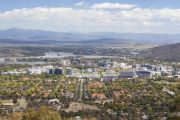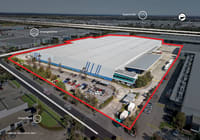
JLL's new virtual reality model, CityViewer, reveals what Sydney will look like in years ahead
With cranes still dotting Sydney’s skyline, it’s a little difficult imagining just what the city will look like in the years ahead.
But new technology has revealed the full extent of the city’s future development pipeline, giving users a bird’s eye view of the city’s network of future buildings and infrastructure projects.
Real estate firm JLL has created an interactive, virtual-reality model of the future Sydney skyline using information from its own research, background data provided by mapping company Aerometrex and cycle-network data from the City of Sydney – information that “broadly covers the next five years,” according to the company.
The model, called “CityViewer”, was built in conjunction with Inspace XR.
“Real estate is a visual asset and we wanted to give people the chance to interact with existing buildings, but more importantly the future development pipeline,” said Andrew Ballantyne, JLL’s head of research in Australia.
“Sydney has evolved to become a genuine mixed-use city and our model covers the residential, office, hotels and student accommodation sectors.”
CityViewer was demonstrated for the first time at the Property Council of Australia’s Future Cities Summit 2019, held in Sydney on May 24.
When users don a pair of VR goggles they step into a virtual replica of the boardroom in JLL’s Queensland headquarters, at 345 Queen Street, Brisbane. On the table is a digital replica of the Sydney CBD which they can then interact with using a handheld remote-control.
The technology is a preview for how JLL envisions virtual reality will become a part of the leasing process. Already the company has employed the technology in a leasing campaign at 80 Collins Street, in Melbourne.
“We wanted to give people the chance to explore our city virtually and understand the impact of new development and infrastructure,” Mr Ballantyne said. “Ultimately, the aim of our project is to evolve into a decision-making tool for real estate investors and occupiers.”
One example of how the technology can help smooth the leasing process for agents and prospective tenants is its ability to categorise buildings according to their environmental credentials.
Users can choose to highlight Green Star-performance-rated buildings. They can also see where planned transport networks will improve connectivity.
“The real estate industry is concerned by sustainability and a number of private and public-sector organisations stipulate minimum sustainability credentials in leasing briefs. Buildings which don’t meet their requirements are excluded,” Mr Ballantyne said.
The reaction to the technology has been overwhelmingly positive, according to JLL’s IT service manager Terry Griffen.
“People are always blown away by the immersive experience,” he said.
Installing CityViewer or any other of JLL’s VR models was as simple as firing up a special-duty laptop and donning a pair of VR goggles. Building a new model for an office fitout took anywhere from two to six weeks, depending on the scale of the project.
Mr Griffen said JLL planned to deploy the technology across several future projects, including pre-sales activity and capital market leasing.
JLL isn’t the only major real estate firm experimenting with interactive technology in the leasing and pre-sales space.
CBRE recently won an award for its Perspectives technology, an interactive digital display tool designed to help agents lease and sell projects without their clients having to physically inspect properties, and which negates the need for expensive display suites.










